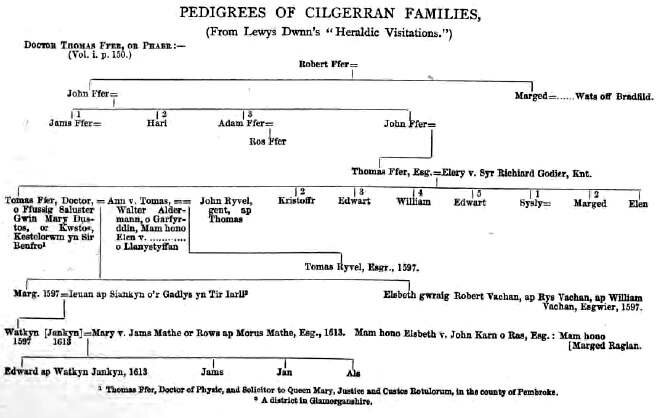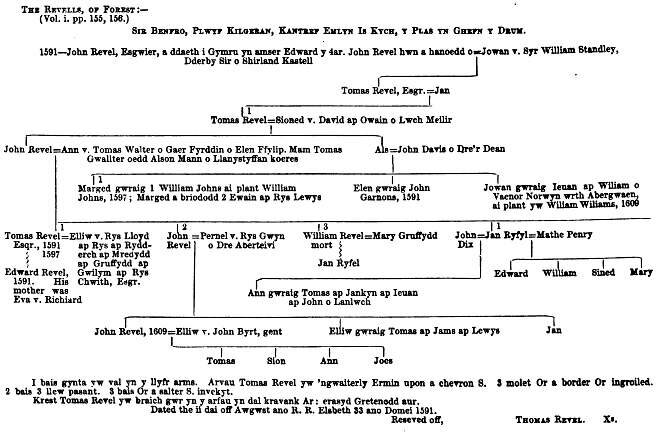Revell Family Study
Wales
Hay Castle at Hay on Wye Powys is said to have been built by William Revel c1090 who was one of Bernard De Neumarch's knights. The lordship of Hay was granted by Bernard de Neumarch in recognition of his part in the conquest of the pre-conquest kingdom of Brycheiniog.
Bernard de Newmarch, companion (or Half brother of) William the Conqueror, held Brecknock, in Wales, and settled there, and founded Brecknock Priory (a cell to Battle Abbey), a priory of Benedictine Monks, and, 'endowing it with extensive lands and revenues' gave it to the abbey of Battel. It is recorded that he married a daughter of GriflTyn, son of Lewelyn, Prince of Wales, and had a son, who, by the infamous conduct of his mother, was deprived of his inheritance.
about Brecknock Priory
Hay Castle
On the conquest of Brecknock by Bernard Newmarch, he granted the manor of Hay to Sir Philip Walwyn, who, in the opinion of some writers, erected a castle here for his own residence and the security of his domains, but does not appear to have remained in possession for long. By a grant of 1121, made by William Revel, to the Benedictine priory at Brecknock, of the church of St. Mary 'at the Hay', it is said to be given with the consent of his lord, Bernard Newmarch, who was present at the dedication, and to whom the entire domain seems now to have belonged. The manor of Hay descended with the other possessions of this nobleman ; and all accounts concur in stating that the castle was at last re-erected by his great grandson on the female side, William de Breos; some even considering him its sole founder *
Deed
The chartulary of the priory of St. John the Evangelist in Brecon contained a transcript of the deed by which the church of the parish of Hay in that county was endowed with tithes. Soon after the conquest the manor of Hay came into the possession of Bernard de Newmarch. Having as yet no church, it was extra-parochial, and all the land which it contained was let out to the occupiers tithe-free. About the close of the eleventh century we find that this great baron, 'various considerations him thereunto moving,' built within the limits of his manor of Hay an edifice in which his domestics and tenants might assemble for religious worship. He erected also a parsonage-house, to which he attached fifteen acres of glebe-land, which are precisely and very particularly described in the grant; and having thus founded a parochial benefice, he expressly endowed it with the tithes accruing from all the land contained within the limits of the parish. The document itself reads:
Bernardus Dei gratia Episcopus de Sancto David, omnibus Sanctae Dei Ecclesiae fidelibus salutem, Deique benedictionera et suam. Sciant tarn presentes quam futuri, quod quando dedicavimus Ecclesiam Beatae Mariae de Haia, Willielmus Revel, concessu Bernard de Novo Mercato qui interfuit dedication, dedit et concessit in perpetuam eleemosinam et dotem ipsius ecclesiae 15 acras terre et duas mansuras terre, videlicet, Levenathi pre- positi ct Alverici bubulci et totam illam terram quae est ab illis mansuris sursum in nemore usque ad divisas de Ewyas * et in bosco et in piano; dedit etiam eidem ecclesie totam decimam totius terre sue de Haia in omnibus rebus et de terra Ivoris et de Meleniauc f et de omnibus illis qui de feudo Haie tenebant. Et ne in posterum inde fiat dubitatio, has determinate dedit et concessit decimas, videlicet, de blado ct fncno et dc pullanis et vitulis, de agnis et porcelli, de lana et caseo et virgulto et de redditu Wallensiutn et Pasnagio et placitis. Quicunque vero aliquid inde subtraxerint vel diminuerint, excoramuniceritur, et a consortio Dei omni- umque sanctorum ejus sequestrentur, donee ad emenda- tionem veniant.'
The parish of Hay joins part of the possessions of the ancient family of Laci, called formerly Ewyas Laci.
Revel of Llanfilo
At Talgarth, on 30 March 1337 Philip son of John Revel of Llanfilo; and John Traneley and Joan his wife. Sun. after the Annunciation, 11 Edw. III - Philip has granted to John and Joan, and their heirs and assigns, for a certain sum of money, 4½ a. of land which he had by grant of William son of Philip Creyn.
Witnesses: Meurice ap Rees, Roger Gunter, Thomas Poleyn, John son of Walter, Stephen son of William, John son of Nicholas, David the smith. (GC2868 Berkeley Castle Muniments )
Visitation of Wales 1591
Parish of Cilgerran, Pembrokehire
Thomas Phaer (Phayer) of Forest, near Cilgerran. Son of Thomas P. of Norwich, (by Clara dau. of Sir William Goodyear Knt. of London,) a member of Lincoln's Inn, M.P. Carmarthen 1547-52, he married Anne daughter of Ald. Thomas Walter of Carmarthen, who made his will 12 Aug. 1560, died at Forest the same year, and was buried in Cilgerran Church. He left 2 daughters and co-heirs, Eleanor and Mary, and his widow married John Revell of Forest.²
John Revell of Shirland Castle, some of whose ancestors had migrated into Wales, from Shirland Castle, in the time of Edward IV.¹ married Anne, widow of Thomas Phaer. They had 3 sons and several daughters:
- Thomas Revell m. Elliw daughter of Rhys Lloyd. He was Sherriff of Cardigan in 1582 and again in 1593.³ No issue. Deputy Lieutenant for Pembrokeshire until 13 Jan 1600
- John m. daughter of Rhys Gwyn Alderman of Borough of Cardigan. He had 1 son and 2 daughters.:
Children of John:
- John m. 1609 to Elliw, (Lucy) daughter of John Birt of Llandurus. 4 children.
- Elliw
- Jane died unmarried
The author states 'And here unfortunately the pedigree as given by Lewys Dwnn comes to a close, owing to the lack of authentic materials it becomes impossible further to trace this family with any degree of certainty. In the records of the borough of Cardigan, about the year 1670, appear the name of one William Revell, as one of the burgesses of that borough ; who was probably a member of this family.
He says If credit be given to tradition it would appear that, in a short time after, the Revells became extinct in this parish ; for when the war broke out between the Parliamentarians and the Royalists in the reign of Charles I. this place was tenanted by a person of the name of Jones, who was a staunch Royalist; and was taken from him by the Parliamentarians, where they thence remained during the time they attacked the castle of Cilgerran.





